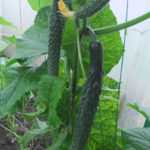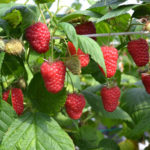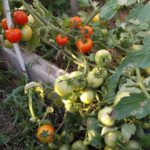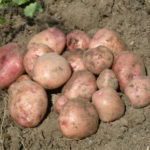Plum variety Smolinka
Smolinka is a medium-ripening variety of Prunus domestica. Bred at the All-Russian Institute of Selection and Technology of Horticulture and Nursery (Moscow) through crossing Ochakovskaya yellow with Renklode Ullensa. The authorship is assigned to H.K. Enikeev and S.N. Satarova.
In 1980, the variety was sent to the State test. In 1990, it was entered into the state register of the Russian Federation for the Central Region (Tula Region).
The trees are vigorous (up to 5 - 5.5 m high). Crohn oval or rounded pyramidal shape, sparse or moderately thickened. The bark of the stem has a rough surface, brown in color, the frequency of the location of lentils is average. Slightly curved shoots, medium-sized internodes. Flower buds are ovoid, vegetative - conical. Leaves are not pubescent, with a rounded-wedge-shaped base, 9.5 cm long, 6.5 cm wide; the edge of the leaf is of medium serration, closer to the apex it is wrapped upward, the consistency of the leaf blade is above average. Petioles of anthocyanin color, with large, greenish-yellow glands. Stipules of medium length, dissected, light green.
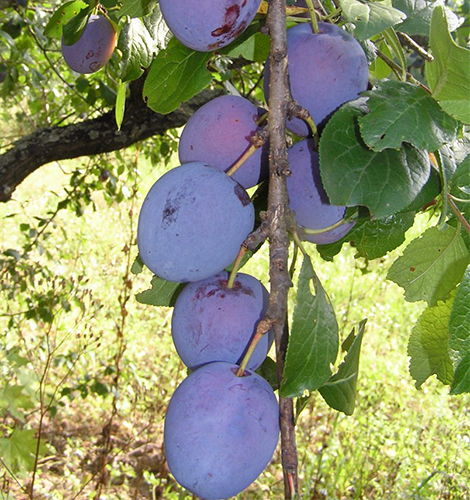
Inflorescences are two-flowered. Corolla of a flower of large diameter, saucer-shaped; the length of the pistil is 17 mm, the column is straight, the stigma is rounded, the calyx is not pubescent. The petals are 14 mm long, 11 mm wide, white in color, there is no corrugation. The buds are white. Sepals are ovoid, 7 mm long, 6 mm wide.
Plum fruits Smolinka large size (weight 35 - 40 g, maximum - 60 g; height - 45 mm, width - 40 mm, thickness - 40 mm), symmetrical in shape, oval-ovoid or rounded-oval. The skin is of medium thickness, dark purple in color, with a thick gray waxy bloom, without streaks. The abdominal suture is underdeveloped. Peduncle size: length - 15 mm, thickness - 1.5 mm. The attachment of the peduncle to the fruit is average.
The bones are of medium size, 23 mm long, with a narrowly rounded base and a pointed apex, the surface is pitted-tuberous, the abdominal suture is medium, the dorsal suture is open, the lateral ribs are clearly visible, the central rib is moderately expressed, the keel is small, visible on the lower half of the bone in the form of a lamellar arcuate outgrowth. The separability from the pulp is average.
The pulp is yellow-green in color, medium density, tender, taste - very good, harmonious, sweet and sour, dessert type. Tasting score - 4.8 points. According to the biochemical composition, the content of the fruits is as follows: the sum of sugars - 11.82%, pectin - 0.8%, sugar-acid index - 15.2. The variety is suitable for fresh consumption, drying and freezing. Some fruits, depending on the degree of ripeness, have a prune flavor.
The early maturity of this plum is average: the trees enter the fruiting season in the 4th - 5th year. The end of shoot growth occurs in the 3rd decade of June, the end of the growing season falls on the 1st decade of October. The fruits ripen on August 14 - 25. Above average yield: on average 4 kg of fruits / square meter of crown projection or 15 - 20 kg of fruits / der. In some favorable years, you can collect up to 40 kg of fruits from a tree. But fruiting is irregular, a good harvest is usually obtained every 3-4 years.
Average winter hardiness. Heat resistance is average. Clasterosporium resistance is relatively high.
The variety is self-fertile. Among the best pollinators of Smolinka, the following varieties are distinguished: Hungarian Moscow, Volga beauty, Superearly, Blue gift, Early ripening red, Opal, Morning, Egg blue.
This variety is of value not only in amateur gardening, but also in breeding work as a source of taste and large-fruited.
The main advantages of Smolinka plum include: high palatability of fruits, large-fruited.
Among the main disadvantages: the frequency of fruiting, insufficient winter hardiness, self-fertility, tall trees (making harvesting difficult), ripe fruits very quickly fall from the trees.
